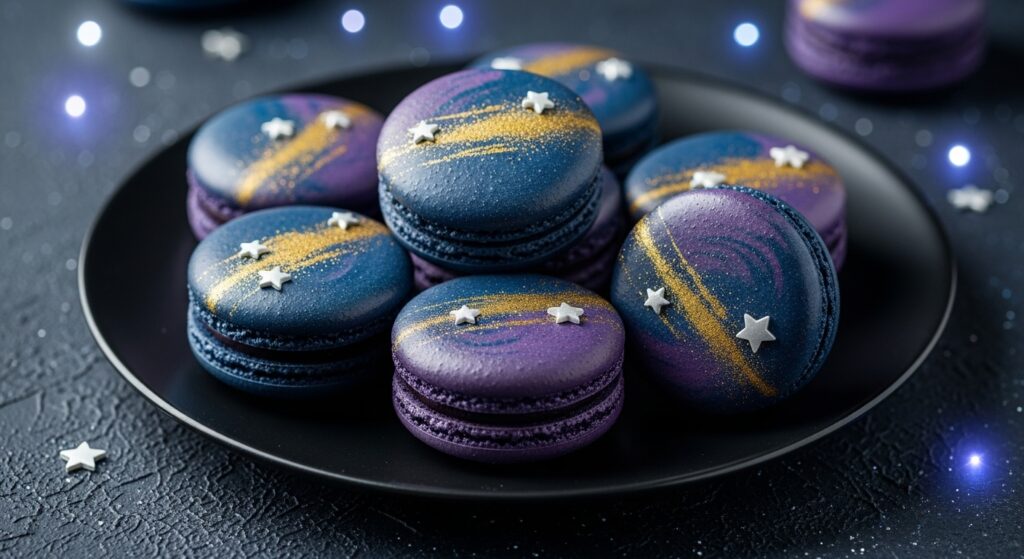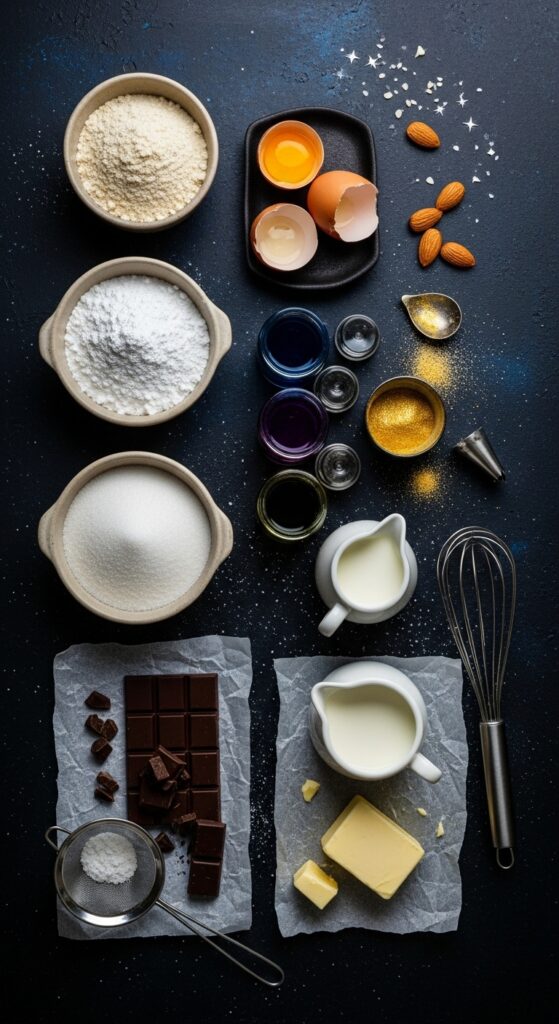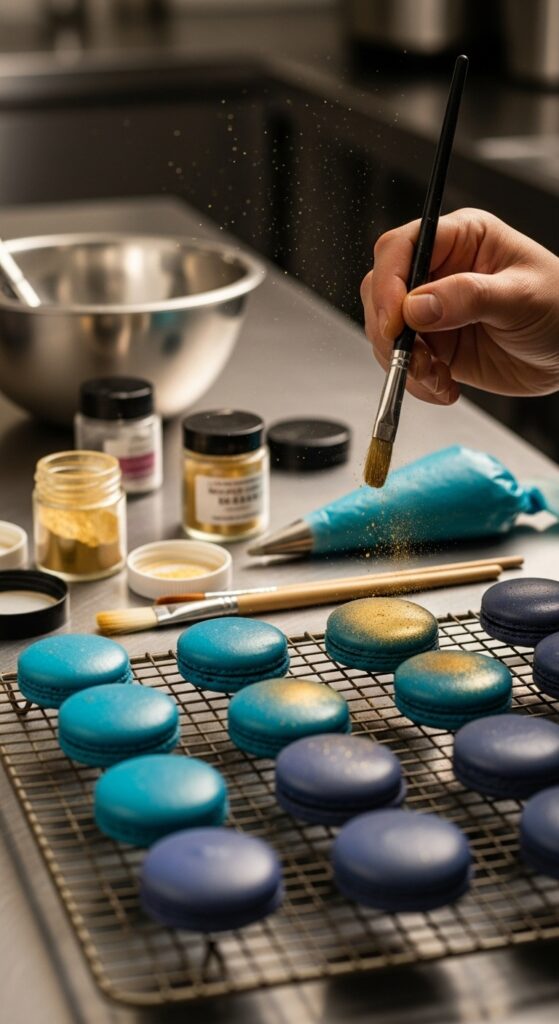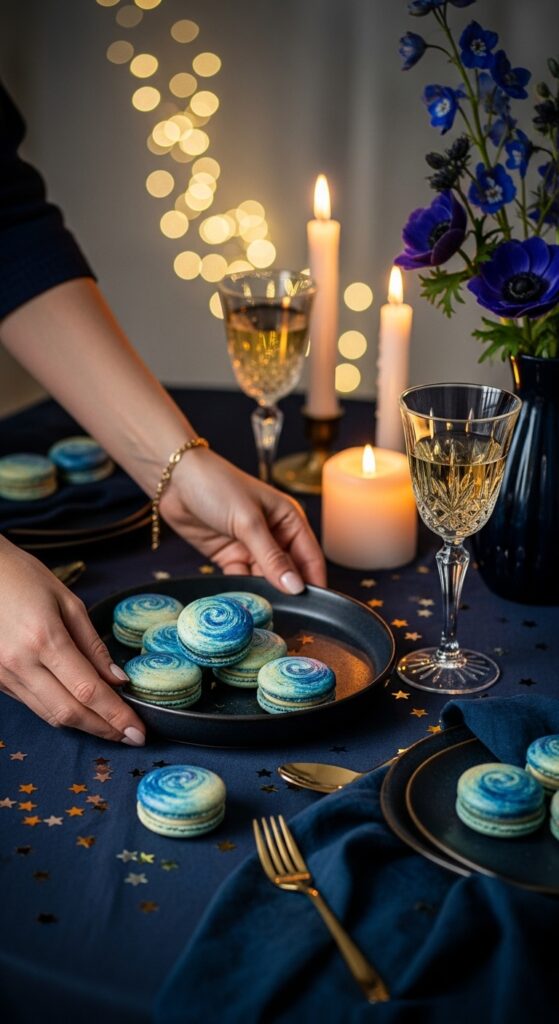Have you ever seen a dessert that looks like it could’ve been painted by Van Gogh himself? Starry Night Macarons shimmer like the midnight sky—tiny, delicate cookies filled with creamy ganache and a swirl of celestial color. They’re the kind of treat that makes people gasp before they even take a bite. It’s art and indulgence rolled into one glossy, little shell.
I remember the first time I made them for a dinner party—half the guests took photos before even touching them. Someone whispered, “They’re too pretty to eat.” And yet, when they did, the compliments didn’t stop. That crisp shell, that chewy almond bite, that lush chocolate center. These aren’t your regular pastel macarons. They’re a showpiece. A galaxy in sugar form.
What makes these Starry Night Macarons special isn’t just the look. It’s the balance—the tender almond shell with its whisper-thin crust, the smooth ganache that melts like starlight on your tongue, and that swirl of midnight blue and gold dust that makes them glow. They taste elegant but feel playful. And if you’ve ever been intimidated by macarons, I promise—this version is totally doable with a few pro tricks up your sleeve.

Ingredients & Substitutions

Macarons are precise little things. They don’t leave much room for improvisation, but once you get the rhythm, they’re wonderfully consistent. For this recipe, we’ll go classic French meringue style—no Italian syrup juggling, just patience and a good whisk arm.
For the shells:
- 120g almond flour (finely ground, blanched almonds)
- 200g powdered sugar
- 100g egg whites (aged overnight, room temperature)
- 100g granulated sugar
- Gel food coloring (navy blue, black, violet for that galaxy swirl)
- Edible gold or silver dust for finishing
For the filling:
- 100g dark chocolate (around 60–70%)
- 80ml heavy cream
- 15g unsalted butter
- Pinch of sea salt
Optional decorations:
- A drop of white food coloring for the “stars”
- A touch of edible glitter if you want that magical sparkle
If you need substitutions:
Can’t find almond flour? Use finely ground almonds, but sift them very well to remove any coarse bits. For a nut-free version, sunflower seed flour works surprisingly well, though it gives a slightly earthier flavor. Vegan? Use aquafaba instead of egg whites (about 100g), but the texture will be a little more delicate.
When it comes to color, use gel or powder colorings, never liquid. Liquid will ruin the consistency of your macaronage and lead to sad, cracked shells. Trust me, I’ve been there.
Step-by-Step Instructions

Making macarons is like conducting a symphony—every step has its rhythm. Follow it closely the first time, and soon you’ll feel the beat yourself.
- Sift and blend. Combine almond flour and powdered sugar in a food processor. Pulse until fine and airy, then sift twice. It’s tedious but essential—this ensures your shells are smooth as silk.
- Whip the meringue. Beat egg whites until they foam. Slowly add the granulated sugar while beating until stiff, glossy peaks form. You want that shiny, bird-beak shape when you lift the whisk.
- Macaronage (folding). Add your dry mix into the meringue. Fold gently but deliberately—press and scoop, press and scoop. Stop when the batter flows like lava and settles into a smooth ribbon. Overmix and it’ll spread too much, undermix and it’ll rise unevenly. The sweet spot is when it forms a slow, shiny trail.
- Color the cosmos. Split the batter into small bowls. Add navy, black, and violet gel colors. Swirl them together in your piping bag without overmixing—this creates that stunning galaxy marbling.
- Pipe the shells. Line your baking tray with parchment or a silicone mat. Pipe 1.5-inch rounds, spacing them evenly. Tap the tray a few times on the counter to release air bubbles.
- Rest them. Leave at room temperature for 30–60 minutes, or until the tops are dry to the touch. This helps them form that classic “foot” when baking.
- Bake. Preheat your oven to 300°F (150°C). Bake for about 15 minutes, rotating halfway through. The shells should rise, form feet, and not crack.
- Cool completely. Don’t touch them too soon—they’re fragile when hot.
- Make the ganache. Heat cream until just steaming. Pour over chopped dark chocolate. Let it sit for a minute, then stir until smooth. Add butter and salt, mix until glossy. Chill slightly until thickened but still spreadable.
- Assemble. Pair up matching shells. Pipe ganache onto one, then gently sandwich with another. Twist slightly to spread the filling.
- Decorate. Dip a clean brush in edible gold dust and lightly flick or paint over the tops. Add a few white dots or silver sparkles for stars. Suddenly, you’ve got a little universe in your hand.
- Age them. The final secret—macarons taste best after 24 hours in the fridge. The shells soften, the filling melds, and everything comes together like magic.
👉 Recipe Card
Starry Night Macarons
Prep Time: 45 minutes
Cook Time: 15 minutes
Resting Time: 45 minutes
Total: ~1 hour 45 minutes (plus aging)
Servings: 20 macarons
Calories: ~120 per macaron
Ingredients
- 120g almond flour
- 200g powdered sugar
- 100g egg whites (room temp)
- 100g granulated sugar
- Food coloring (navy, violet, black)
- Edible gold dust
- 100g dark chocolate
- 80ml heavy cream
- 15g butter
- Pinch of salt
Instructions
- Process and sift almond flour + powdered sugar.
- Whip egg whites with granulated sugar to stiff peaks.
- Fold dry mix into meringue (macaronage) until shiny ribbons form.
- Add colors and swirl lightly.
- Pipe circles on lined tray; rest 30–60 mins.
- Bake 15 mins at 300°F (150°C). Cool.
- Make ganache with cream, chocolate, butter, and salt.
- Pipe filling between two shells.
- Decorate with gold dust.
- Chill 24 hours before serving.
Cooking Techniques & Science

Macarons might seem mystical, but it’s just chemistry that behaves beautifully when you respect it. That stiff meringue? It traps air bubbles that create the rise and that delicate “foot.” The resting step forms a skin that keeps the tops smooth. And that precise temperature? It’s the difference between golden perfection and hollow heartbreak.
Egg whites are key here. Aging them overnight helps reduce moisture, giving you a more stable meringue. Always use metal or glass bowls—plastic can trap grease, which kills the foam.
Your almond flour and sugar need to be ultra-fine. Even a few coarse grains can create bumps. Some bakers go as far as drying their almond flour in the oven for a few minutes to remove hidden moisture—smart move if you live somewhere humid.
For the ganache, fat balance is everything. Too hot and it splits, too cold and it stiffens before spreading. Always pour hot cream over chocolate (never the other way), and let it sit before stirring. Patience again—it’s the secret to a glossy finish.
Tool-wise, a kitchen scale is non-negotiable. Macarons are precise. Eyeballing ingredients is like guessing rocket fuel ratios—you’ll crash before you fly. Use a good piping bag with a round tip (around ½ inch). Silicone mats make consistent shapes, while parchment can warp under heat.
Serving & Pairing Suggestions

Starry Night Macarons aren’t everyday cookies. They deserve a little ceremony. Serve them chilled, not cold, so the ganache has that smooth, melt-in-your-mouth texture. Arrange them on a black or dark blue platter—those cosmic colors pop beautifully under soft lighting.
Pair them with espresso for a sharp contrast, or champagne if you’re going for elegant. They also work with a floral tea like jasmine or lavender—those subtle notes dance well with the dark chocolate.
If you’re hosting a themed dinner, make a little constellation platter—dust each flavor variation with a different shimmer (silver for vanilla, rose gold for raspberry, etc.). Suddenly, dessert becomes a universe.
Conclusion
Making Starry Night Macarons isn’t just about baking—it’s a little meditation on patience, beauty, and precision. You pipe, you wait, you decorate, and when you finally bite into one, it’s pure joy. Each piece feels like a tiny masterpiece, proof that food can be both art and comfort.
Don’t stress if your first batch isn’t perfect. Everyone’s first dozen macarons are rebellious little things. Cracked shells, hollow centers—it happens. But the second time, your hands remember the texture, your eyes learn the shine, and it all starts to click. That’s the magic.
So take your time. Whisk those egg whites. Swirl those colors. Paint your golden stars. And when you finally hand someone a plate of Starry Night Macarons and see that sparkle in their eyes—you’ll know it was worth it.
FAQs
1. Why did my macarons crack?
Usually because the shells didn’t rest long enough, or your oven ran too hot. Try adding 10 more minutes of drying time and use an oven thermometer to check accuracy.
2. Can I make these without almond flour?
Yes, sunflower seed flour works as a nut-free alternative. Just note the color and taste shift slightly.
3. How long do macarons keep?
They stay fresh for 4–5 days in the fridge, stored airtight. You can freeze them (filled or unfilled) for up to a month. Thaw overnight in the fridge before serving.
4. Can I use white chocolate instead of dark?
Definitely, though you’ll need to reduce the cream slightly since white chocolate melts softer. Try 70ml cream instead of 80ml.
5. What’s the best way to get that galaxy swirl?
Don’t fully mix the colors—just spoon little streaks of each into your piping bag and let them swirl naturally as you pipe. The randomness is what makes it look like the night sky.

Selena is an experienced lifestyle blogger and the voice behind many of Cozy Toned’s inspiring posts. With a passion for mindful living, home styling, and everyday wellness, she shares practical tips and fresh ideas to help readers live beautifully and intentionally.
